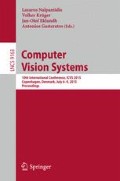Abstract
An autonomous agent using manmade objects must understand how task conditions the grasp placement. In this paper we formulate task based robotic grasping as a feature learning problem. Using a human demonstrator to provide examples of grasps associated with a specific task, we learn a representation, such that similarity in task is reflected by similarity in feature. The learned representation discards parts of the sensory input that is redundant for the task, allowing the agent to ground and reason about the relevant features for the task. Synthesized grasps for an observed task on previously unseen objects can then be filtered and ordered by matching to learned instances without the need of an analytically formulated metric. We show on a real robot how our approach is able to utilize the learned representation to synthesize and perform valid task specific grasps on novel objects.
This work was supported by the Swedish Foundation for Strategic Research, the Belgian National Fund for Scientific Research (Fnrs), the Swedish Research Council, and the EU project EU ERC FLEXBOT.
Access this chapter
Tax calculation will be finalised at checkout
Purchases are for personal use only
References
Song, D., Huebner, K., Kyrki, V., Kragic, D.: Learning task constraints for robot grasping using graphical models. In: IROS (2010)
Song, D., Ek, C.H., Huebner, K., Kragic, D.: Embodiment-specific representation of robot grasping using graphical models and latent-space discretization. In: IROS, pp. 980–986 (2011)
Saxena, A., Driemeyer, J., Ng, A.Y.: Robotic grasping of novel objects using vision. Int. J. Robot. Res. 27(2), 157–173 (2008)
Boularias, A., Kroemer, O., Peters, J.: Learning robot grasping from 3-D images with Markov Random Fields. In: IROS, pp. 1548–1553 (2011)
Detry, R., Ek, C.H., Madry, M., Kragic, D.: Learning a dictionary of prototypical grasp-predicting parts from grasping experience. In: ICRA (2011)
Herzog, A., Pastor, P., Kalakrishnan, M., Righetti, L., Asfour, T., Schaal, S.: Template-based learning of grasp selection. In: ICRA (2012)
Kroemer, O., Ugur, E., Oztop, E., Peters, J.: A kernel-based approach to direct action perception. In: ICRA, pp. 2605–2610 (2012)
Ying, L., Fu, J.L., Pollard, N.S.: Data-driven grasp synthesis using shape matching and task-based pruning. IEEE Trans. Visual Comput. Graphics 13(4), 732–747 (2007)
Stark, M., Lies, P., Zillich, M., Wyatt, J.C., Schiele, B.: Functional object class detection based on learned affordance cues. In: Gasteratos, A., Vincze, M., Tsotsos, J.K. (eds.) ICVS 2008. LNCS, vol. 5008, pp. 435–444. Springer, Heidelberg (2008)
Aleotti, J., Caselli, S.: Part-based robot grasp planning from human demonstration. In: ICRA, pp. 4554–4560 (2011)
Hjelm, M., Detry, R., Ek, C.H., Kragic, D.: Cross-object grasp transfer. In: ICRA, Representations for Cross-task (2014)
Weinberger, K.Q., Saul, L.K.: Distance metric learning for large margin nearest neighbor classification. J. Mach. Learn. Res. 10, 207–244 (2009)
Bertenthal, B.I.: Origins and early development of perception, action, and representation. Annu. Rev. Psychol. 47(1), 431–459 (1996)
Berthier, N.E., Clifton, R.K., Gullapalli, V., McCall, D.D., Robin, D.J.: Visual information and object size in the control of reaching. J. Mot. Behav. 28(3), 187–197 (1996)
Csurka, G., Dance, C., Fan, L., Willamowski, J., Bray, C.: Visual categorization with bags of keypoints. In: Workshop on Statistical Learning in Computer Vision, ECCV, vol. 1, pp. 1–2. Prague (2004)
Rusu, R.B., Blodow, N., Beetz, M.: Fast Point Feature Histograms (FPFH) for 3D registration. In: ICRA, pp. 3212–3217 (2009)
Felzenszwalb, P.F., Huttenlocher, D.P.: Efficient graph-based image segmentation. Int. J. Comput. Vis. 59(2), 167–181 (2004)
Bergström, N., Bohg, J., Kragic, D.: Integration of visual cues for robotic grasping. In: Fritz, M., Schiele, B., Piater, J.H. (eds.) ICVS 2009. LNCS, vol. 5815, pp. 245–254. Springer, Heidelberg (2009)
Author information
Authors and Affiliations
Corresponding author
Editor information
Editors and Affiliations
Rights and permissions
Copyright information
© 2015 Springer International Publishing Switzerland
About this paper
Cite this paper
Hjelm, M., Ek, C.H., Detry, R., Kragic, D. (2015). Learning Human Priors for Task-Constrained Grasping . In: Nalpantidis, L., Krüger, V., Eklundh, JO., Gasteratos, A. (eds) Computer Vision Systems. ICVS 2015. Lecture Notes in Computer Science(), vol 9163. Springer, Cham. https://doi.org/10.1007/978-3-319-20904-3_20
Download citation
DOI: https://doi.org/10.1007/978-3-319-20904-3_20
Published:
Publisher Name: Springer, Cham
Print ISBN: 978-3-319-20903-6
Online ISBN: 978-3-319-20904-3
eBook Packages: Computer ScienceComputer Science (R0)

